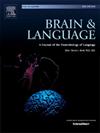从眼睛到大脑皮层:双语小说词汇习得的神经认知动态追踪
IF 2.3
2区 心理学
Q1 AUDIOLOGY & SPEECH-LANGUAGE PATHOLOGY
引用次数: 0
摘要
目前的研究考察了母语(L1)正字法特征如何影响双语者快速形成第二语言(L2)书面单词形式的新表征的能力。我们评估了在(西班牙-英语)和(汉语-英语)书写系统中使用L1-L2拼写对的顺序双语者的眼球运动、神经活动和行为表现。参与者接受了包含在自然句子语境中的新英语单词的培训,随后是为期两天的培训后课程。对眼动变量、注视相关电位和学习结果的分析表明,西班牙-英语双语者在新单词的自动词汇编码上表现得更强,反映在更短的注视和减弱的早期神经反应上,而中-英语双语者在不同的接触中保持更长的注意参与。这些不同的与暴露相关的动态预测了训练后的表现,西班牙双语者在巩固后表现出更大的进步。研究结果表明,二语词汇学习背后的神经可塑性是由针对母语语言特征的预先存在的皮层回路塑造的,从而导致形成新的词汇表征的不同神经策略。本文章由计算机程序翻译,如有差异,请以英文原文为准。
From eye to cortex: Tracing the neurocognitive dynamics of bilingual novel word acquisition
The current study examined how native language (L1) orthographic features influence bilinguals’ ability to rapidly form new representations for second-language (L2) written word forms. We assessed eye movements, neural activity, and behavioral performance in sequential bilinguals with L1-L2 orthographical pairs within (Spanish-English) and across (Mandarin Chinese-English) writing systems. Participants were trained on novel English words embedded in naturalistic sentence contexts, followed by a two-day post-training session. Analyses of eye-movement variables, fixation-related potentials, and learning outcomes revealed that Spanish-English bilinguals exhibited more automatic lexical encoding of novel words, reflected in shorter fixations and attenuated early neural responses, whereas Chinese-English bilinguals maintained prolonged attentional engagement across exposures. These divergent exposure-related dynamics predicted post-training performance, with Spanish bilinguals showing greater gains after consolidation. The findings suggest that the neuroplasticity underlying L2 word learning is shaped by pre-existing cortical circuits for native linguistic features, leading to different neural strategies for forming new lexical representations.
求助全文
通过发布文献求助,成功后即可免费获取论文全文。
去求助
来源期刊

Brain and Language
医学-神经科学
CiteScore
4.50
自引率
8.00%
发文量
82
审稿时长
20.5 weeks
期刊介绍:
An interdisciplinary journal, Brain and Language publishes articles that elucidate the complex relationships among language, brain, and behavior. The journal covers the large variety of modern techniques in cognitive neuroscience, including functional and structural brain imaging, electrophysiology, cellular and molecular neurobiology, genetics, lesion-based approaches, and computational modeling. All articles must relate to human language and be relevant to the understanding of its neurobiological and neurocognitive bases. Published articles in the journal are expected to have significant theoretical novelty and/or practical implications, and use perspectives and methods from psychology, linguistics, and neuroscience along with brain data and brain measures.
 求助内容:
求助内容: 应助结果提醒方式:
应助结果提醒方式:


